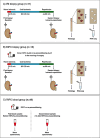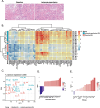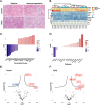Defining the molecular response to ischemia-reperfusion injury and remote ischemic preconditioning in human kidney transplantation
- PMID: 39471208
- PMCID: PMC11521294
- DOI: 10.1371/journal.pone.0311613
Defining the molecular response to ischemia-reperfusion injury and remote ischemic preconditioning in human kidney transplantation
Abstract
Background: Ischemia-reperfusion injury (IRI) inevitably occurs during kidney transplantation and extended ischemia is associated with delayed graft function and poor outcomes. Remote ischemic preconditioning (RIPC) is a simple, noninvasive procedure aimed at reducing IRI and improving graft function. Experimental studies have implicated the kynurenine pathway as a protective mechanism behind RIPC.
Methods: First, paired biopsies from 11 living kidney donors were analyzed to characterize the acute transcriptomic response to IRI. Second, 16 living kidney donors were subjected to either RIPC (n = 9) or no pretreatment (n = 7) to evaluate the impact of RIPC on the transcriptomic response to IRI. Finally, the effect of RIPC on plasma metabolites was analyzed in 49 healthy subjects.
Results: There was a robust immediate response to IRI in the renal transcriptomes of living-donor kidney transplantation, including activation of the mitogen-activated protein kinase (MAPK) and epidermal growth factor receptor (EGFR) pathways. Preconditioning with RIPC did not significantly alter the transcriptomic response to IRI or the concentration of plasma metabolites.
Conclusions: The present data validate living-donor kidney transplantation as a suitable model for mechanistic studies of IRI in human kidneys. The failure of RIPC to alter transcriptomic responses or metabolites in the kynurenine pathway raises the question of the robustness of the standard procedure used to induce RIPC, and might explain the mixed results in clinical trials evaluating RIPC as a method to attenuate IRI.
Copyright: © 2024 Nordström et al. This is an open access article distributed under the terms of the Creative Commons Attribution License, which permits unrestricted use, distribution, and reproduction in any medium, provided the original author and source are credited.
Conflict of interest statement
J.S.R. reports funding from GSK and Sanofi and fees from Travere Therapeutics and Astex. This does not alter our adherence to PLOS ONE policies on sharing data and materials. There are no patents, products in development, or marketed products associated with this research to declare.
Figures




Similar articles
-
Remote ischemic preconditioning attenuates ischemia-reperfusion injury-induced reductions in vascular function through release of endogenous opioids.J Appl Physiol (1985). 2025 Feb 1;138(2):571-576. doi: 10.1152/japplphysiol.00913.2024. Epub 2025 Jan 17. J Appl Physiol (1985). 2025. PMID: 39819103
-
Remote ischemic preconditioning: a novel protective method from ischemia reperfusion injury--a review.J Surg Res. 2008 Dec;150(2):304-30. doi: 10.1016/j.jss.2007.12.747. Epub 2008 Jan 22. J Surg Res. 2008. PMID: 19040966 Review.
-
Effect of Remote Ischemic Preconditioning Conducted in Living Liver Donors on Postoperative Liver Function in Donors and Recipients Following Liver Transplantation: A Randomized Clinical Trial.Ann Surg. 2020 Apr;271(4):646-653. doi: 10.1097/SLA.0000000000003498. Ann Surg. 2020. PMID: 31356262 Clinical Trial.
-
Early remote ischaemic preconditioning leads to sustained improvement in allograft function after live donor kidney transplantation: long-term outcomes in the REnal Protection Against Ischaemia-Reperfusion in transplantation (REPAIR) randomised trial.Br J Anaesth. 2019 Nov;123(5):584-591. doi: 10.1016/j.bja.2019.07.019. Epub 2019 Sep 11. Br J Anaesth. 2019. PMID: 31521337 Clinical Trial.
-
Protocols and mechanisms for remote ischemic preconditioning: a novel method for reducing ischemia reperfusion injury.Transplantation. 2007 Aug 27;84(4):445-58. doi: 10.1097/01.tp.0000228235.55419.e8. Transplantation. 2007. PMID: 17713425 Review.
Cited by
-
Effects of remote ischemic preconditioning and/or erythropoietin on lung injury induced by skeletal ischemia reperfusion: role of the NLRP3 inflammasome.Inflamm Res. 2025 Apr 24;74(1):67. doi: 10.1007/s00011-025-02033-4. Inflamm Res. 2025. PMID: 40272513
References
-
- Long YQ, Feng XM, Shan XS, Chen QC, Xia Z, Ji FH, et al.. Remote Ischemic Preconditioning Reduces Acute Kidney Injury After Cardiac Surgery: A Systematic Review and Meta-analysis of Randomized Controlled Trials. Anesth Analg. 2022. Mar 1;134(3):592–605. doi: 10.1213/ANE.0000000000005804 - DOI - PubMed
MeSH terms
Substances
LinkOut - more resources
Full Text Sources
Medical
Research Materials
Miscellaneous

